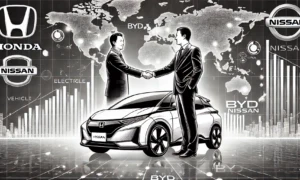Introduction: Apple Inc., one of the world’s most valuable companies, is renowned not only for its innovative products but also for its highly efficient and complex global supply chain. The company’s supply chain plays a pivotal role in ensuring that Apple can meet the demand for its products, maintain high-quality standards, reduce costs, and maximize profitability. Apple’s ability to manage and streamline its supply chain has been a key factor in its success, enabling the company to stay ahead of its competitors in both the tech industry and global markets.
This case study explores how Apple manages its global supply chain, examining the company’s supply chain strategy, key challenges, and the technologies and practices that help Apple maintain its position as a leader in the tech industry.
1. Apple’s Global Supply Chain Overview
Apple operates a highly integrated global supply chain, involving a vast network of suppliers, manufacturers, logistics partners, and retailers. With the production of its iconic devices such as the iPhone, iPad, Mac, and Apple Watch, Apple’s supply chain spans across multiple continents, including Asia, Europe, and the Americas.
Key elements of Apple’s supply chain include:
- Raw Materials and Component Sourcing: Apple sources components like processors, displays, batteries, and chips from various suppliers, many of which are located in Asia.
- Manufacturing: Apple’s manufacturing partners, including Foxconn, Pegatron, and Wistron, assemble the majority of its products in factories in China, India, and other parts of Asia.
- Logistics and Distribution: Apple has a sophisticated logistics and distribution network to ensure that products reach consumers across the world quickly and efficiently.
- Retail: Apple’s retail stores, as well as its online store, are key touchpoints for customers to purchase products and engage with the brand.
Apple’s supply chain strategy is characterized by vertical integration, supplier relationships, and cost control, all of which contribute to the company’s profitability.
2. Key Features of Apple’s Supply Chain Strategy
a. Supplier Relationships and Strategic Partnerships
One of the key strategies behind Apple’s successful global supply chain is its ability to form and maintain long-term, strategic relationships with suppliers. Apple’s relationship with its suppliers is built on a foundation of mutual trust, strict quality standards, and high-volume orders. By working closely with suppliers, Apple ensures that it can secure the best components for its products at competitive prices.
Key elements of these relationships include:
- Exclusive Deals: Apple often enters into exclusive supply agreements with key suppliers, ensuring that critical components like A-series chips, displays, and memory are available in the quantities needed to meet demand.
- Supplier Audits and Standards: Apple is known for setting high-quality standards and conducting rigorous audits of its suppliers to ensure they meet the company’s ethical, environmental, and quality requirements.
- Supplier Investment: Apple has invested in its suppliers, often providing them with capital to help them expand their manufacturing capabilities. This ensures a reliable supply of key components and strengthens Apple’s position as a primary customer.
b. Global Sourcing and Component Manufacturing
Apple’s supply chain spans the globe, with its most critical suppliers located in Asia, particularly in China, Taiwan, and South Korea. For instance:
- Foxconn (also known as Hon Hai Precision Industry), Apple’s largest supplier, assembles most of its products, including iPhones, at factories in China.
- Apple sources key components such as processors (A-series chips) from TSMC in Taiwan, displays from Samsung in South Korea, and batteries from suppliers in China.
This global sourcing strategy helps Apple minimize costs by leveraging the best suppliers in different regions while maintaining control over the quality and availability of components.
c. Vertical Integration and Control Over the Production Process
Apple’s level of vertical integration is one of the key drivers of its supply chain efficiency. The company does not simply rely on external suppliers; it also controls key aspects of its production process to maintain strict oversight and ensure the highest quality.
- In-House Chip Production: Apple’s in-house chip development (e.g., the A-series and M-series processors) gives the company greater control over the design and manufacturing of crucial components, reducing reliance on third-party suppliers.
- Quality Control: Apple maintains strict quality control throughout the production process. The company’s engineering and design teams work closely with suppliers to ensure that components meet Apple’s high standards.
- Manufacturing Expertise: Apple’s focus on maintaining relationships with its contract manufacturers, such as Foxconn, allows the company to retain control over assembly lines and integrate advanced technology into production processes.
d. Inventory and Just-In-Time (JIT) Manufacturing
Apple’s use of Just-In-Time (JIT) manufacturing ensures that products are only built and shipped when needed, reducing excess inventory costs. This strategy also helps Apple mitigate the risks associated with overproduction, especially in a fast-moving tech market.
- Efficient Inventory Management: Apple has developed advanced systems for tracking inventory levels and ensuring that products are manufactured and shipped to meet market demand.
- Demand Forecasting: Apple uses sophisticated demand forecasting models to predict consumer demand for products, ensuring that its supply chain is optimized to meet this demand without significant delays.
3. Challenges Faced by Apple’s Supply Chain
While Apple’s supply chain has been a significant factor in its success, it has not been without challenges. These include:
a. Geopolitical Risks
Apple’s reliance on suppliers and manufacturing partners in countries like China exposes it to significant geopolitical risks. Trade tensions between the U.S. and China, for example, have led to concerns about tariffs and supply chain disruptions. In response, Apple has begun shifting some of its production out of China to India and Vietnam to diversify its supply chain and reduce reliance on one region.
b. Labor and Ethical Concerns
Apple has faced scrutiny over working conditions at its manufacturing plants, particularly those operated by Foxconn in China. The company has made efforts to improve labor conditions and conduct supplier audits, but it remains a challenge to ensure fair wages and safe working conditions across its extensive network of suppliers.
c. Supply Chain Disruptions
The COVID-19 pandemic highlighted the vulnerabilities in global supply chains, as lockdowns and factory closures disrupted the flow of components and finished products. Apple responded by diversifying its supplier base and investing in supply chain resilience, but disruptions in key areas like semiconductor shortages continue to affect the tech industry.
d. Sustainability and Environmental Concerns
Apple’s supply chain is often scrutinized for its environmental impact. The company has committed to making its supply chain more sustainable by focusing on using recycled materials, reducing carbon emissions, and improving energy efficiency. Apple has also set ambitious goals to make its products 100% recycled and carbon-neutral by 2030. Achieving these goals requires close collaboration with suppliers to ensure compliance with environmental standards.
4. Technology and Innovation in Supply Chain Management
Apple leverages advanced technologies to optimize its supply chain, ensuring efficiency and cost-effectiveness. Some of the key technologies include:
a. Artificial Intelligence and Data Analytics
Apple uses AI and machine learning to improve its demand forecasting, inventory management, and production planning. By analyzing large amounts of data from various sources, including sales trends, weather patterns, and market conditions, Apple can optimize its supply chain and minimize stockouts or overproduction.
b. Blockchain and Supply Chain Transparency
To enhance supply chain transparency and trace the origins of materials, Apple has explored the use of blockchain technology. Blockchain can help track the movement of components through the supply chain, ensuring that materials are sourced ethically and sustainably.
c. Robotic Process Automation (RPA)
Apple has implemented RPA in its supply chain to automate routine tasks like inventory tracking, order fulfillment, and quality checks. This helps reduce human error and improve overall operational efficiency.
5. Apple’s Supply Chain Performance and Impact on Profitability
Apple’s ability to maintain a highly efficient supply chain has contributed significantly to its profitability. The company has a highly responsive supply chain that allows it to quickly launch new products while maintaining low levels of inventory. Apple also enjoys economies of scale due to the massive volumes it orders from suppliers, which helps reduce per-unit costs.
Additionally, Apple’s global supply chain allows it to source high-quality components at competitive prices, ensuring that its products maintain premium quality while being sold at high margins. The efficiency of Apple’s supply chain has allowed the company to remain profitable and sustain its competitive advantage in the tech industry.
6. Conclusion
Apple’s global supply chain management is a key factor behind its success. Through strategic supplier relationships, vertical integration, and advanced technologies, Apple has created a supply chain that is both efficient and resilient. Despite facing challenges such as geopolitical risks, ethical concerns, and supply chain disruptions, Apple continues to adapt and innovate to ensure the success of its products in the marketplace. As the company moves toward greater sustainability and resilience, its supply chain will remain an essential part of its strategy to maintain profitability and competitiveness in the global tech industry.



